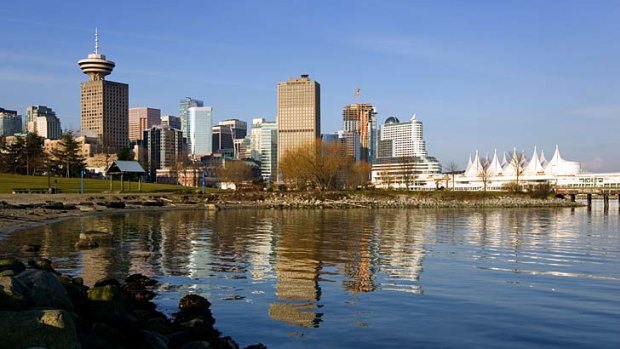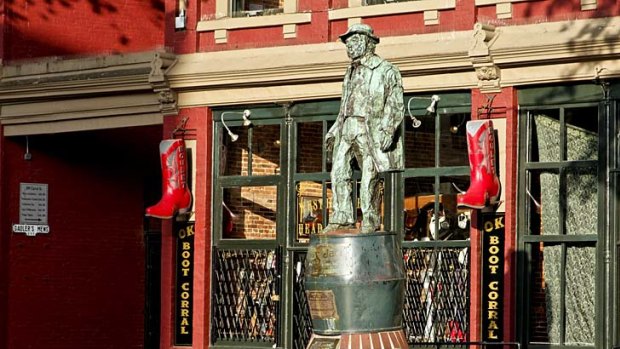
'We've been very, very bad' ... Vancouver regularly ranks among the world's most liveable cities, but it has a dark past.Credit: Getty Images
It may be one of the world's most liveable cities, but Vancouver has a dark past, Tim Richards discovers.
"We're a very, very young city, and yet in that short history we've been very, very bad. Particularly when it comes to vice crimes – lots of single men with nothing else to do, so what are they going to do? They're going to drink themselves silly, they're going to gamble, a little bit of drugs on the side and they're going to find a woman for the comforts of home."
So much for Canadians' reputation for terminal niceness, at least according to Chris Mathieson, executive director of the Vancouver Police Museum. Canadians are easy people to get along with, Vancouver has often been rated the world's most liveable city, and Americans never tire of making fun of their northern neighbours' famed politeness. But Chris is having none of it.
"Vancouver was a colourful city that way, for sure," he adds, and he has a point. Growing from a rough-and-tumble logging settlement on the sprawling nation's remote Pacific coast, the city had its own Wild West period. And it happened not so long ago – it wasn't until 1886 that the city was officially named, whereupon it promptly burned to the ground.
Over a century later, modern Vancouver is a shiny attractive city of restored historic zones and beautiful waterways; but the city's dark side is still accessible via the museum's 'Sins of the City' tour, run through the seedy Downtown Eastside district which abuts the tourist-friendly Gastown.
Today's tour guide is the knowledgeable young Jessica O'Neill. She meets tour members on the steps of the Police Museum, once the Coroner's Court and still exuding a tone of grim authority via its solid brick facade.

Vancouver's unofficial founder, John 'Gassy Jack' Deighton.Credit: Getty Images
There are many macabre delights within, including preserved body sections from crime victims and the autopsy report of Tasmania's own Hollywood star Errol Flynn, who died in Vancouver. But we're stepping out under grey skies onto the city's streets, to follow an account of sin and shame.
As we walk, Jessica talks about "Gassy Jack" (John Deighton), the unofficial founder of the township which became the nucleus of Vancouver. Jack opened a saloon here in 1867, to serve nearby loggers and sawmill workers. In typically flamboyant fashion, he persuaded the sawmill workers to build his bar for free, in exchange for as much whisky as they could down in a single sitting.
Prostitution was an inevitable accompaniment to the booze as the local population grew, and in 1870 the first brothel opened next to Gassy Jack's establishment. A Chinatown grew up nearby as Asian migrants arrived for work, and this housed opium dens. It was, to judge from Jessica's narrative, a spectacular hotbed of vice.
Next we arrive at a large tiled image set in the footpath, bearing the year 1907. In its centre is a mosaic depicting a noodle house with Chinese lettering and jagged smashed windows. This historical marker notes one of Vancouver's great shames, the massive race riots of that year which saw angry mobs ransack the Chinese quarter.
Then it's back to the topic of prostitution, as we pass along streets which are quiet by day, but house brothels by night. There's some attractive architecture here – graceful brick apartment buildings sporting bow windows with green gables – but there's also a windswept, empty atmosphere on this inclement day.
The former Japantown is next on the walk, where another marker records the internment of Canadians of Japanese descent during World War II. This forced resettlement and the following knock-down sale of homes and businesses effectively destroyed the community, though a few Japanese made their way back after the war (Jessica says the area housed the only sushi restaurants in the whole city in the 1970s). There's a melancholy aura about this vanished community, especially when compared to the vibrancy of nearby Chinatown.
We pass a lurid orange exterior left over from Vancouver's 1970s strip scene, when dinner clubs which featured topless stripping morphed into raunchy venues presenting all-the-way naked extravaganzas, and then we're in the Chinese district.
The low-rise brick exteriors of Chinatown contrast sharply with the modern apartment buildings towering nearby, sighted above the street signage with its Chinese characters and decorative dragons.
The modern city is a picture of prim propriety compared with the gambling, drugs and prostitution that used to exist here, according to Jessica. However the rumours of secrets tunnels are false, she says, though some buildings had interconnected basements which would allow patrons to enter and leave gambling dens discreetly.
On our way to the edge of Gastown, we pass Blood Alley. Its name is as mysterious as it is evocative, and over the next few days Vancouver residents will tell me various conflicting stories about its origin. Depending on how over-excited you feel, it's either named after an execution site or a set of butchers' shops, or is possibly just a clever marketing idea. Whichever is true, the alley is full of rough character and also contains an excellent wine bar called Salt Tasting Room.
The tour ends at Gassy Jack's statue, near the location where his raucous bar once stood, and we pause in regret at its demolition after his death.
In the absence of Jack's tavern, the greatest tribute to Vancouver's sinful past comes when Jessica, umbrella aloft, reads out the lyrics of a song once written about the former Grand Hotel which operated nearby. One memorable verse finishes with the words "Till they all get so boozy they can't drink no more, and the loggers lay scattered all over the floor."
Gassy Jack would be so proud.
Tim Richards travelled courtesy of the Canadian Tourism Commission.
FAST FACTS
Getting there
Air Canada (1300 655 767; www.aircanada.com) flies daily from Sydney to Vancouver.
Staying there
The Pan Pacific Vancouver, (+1 604 662 8111; www.panpacific.com) has classy rooms with spectacular water views from $270 per night, depending on season.
An attractively priced alternative is the boutique 19th century Victorian Hotel (+1 604 681 6369; www.victorianhotel.ca), with rooms from $90 per night.
Touring there
Sins of the City departs from the Police Museum, 240 East Cordova Street, at 4pm on Wednesdays, Fridays and Saturdays from May to September (+1 604 665 3346; www.vancouverpolicemuseum.ca). Admission is $14, adults only.
Follow the Traveller section on Twitter @FairfaxTravel
Sign up for the Traveller Deals newsletter
Get exclusive travel deals delivered straight to your inbox. Sign up now.